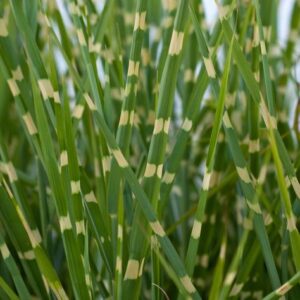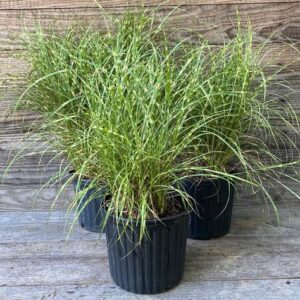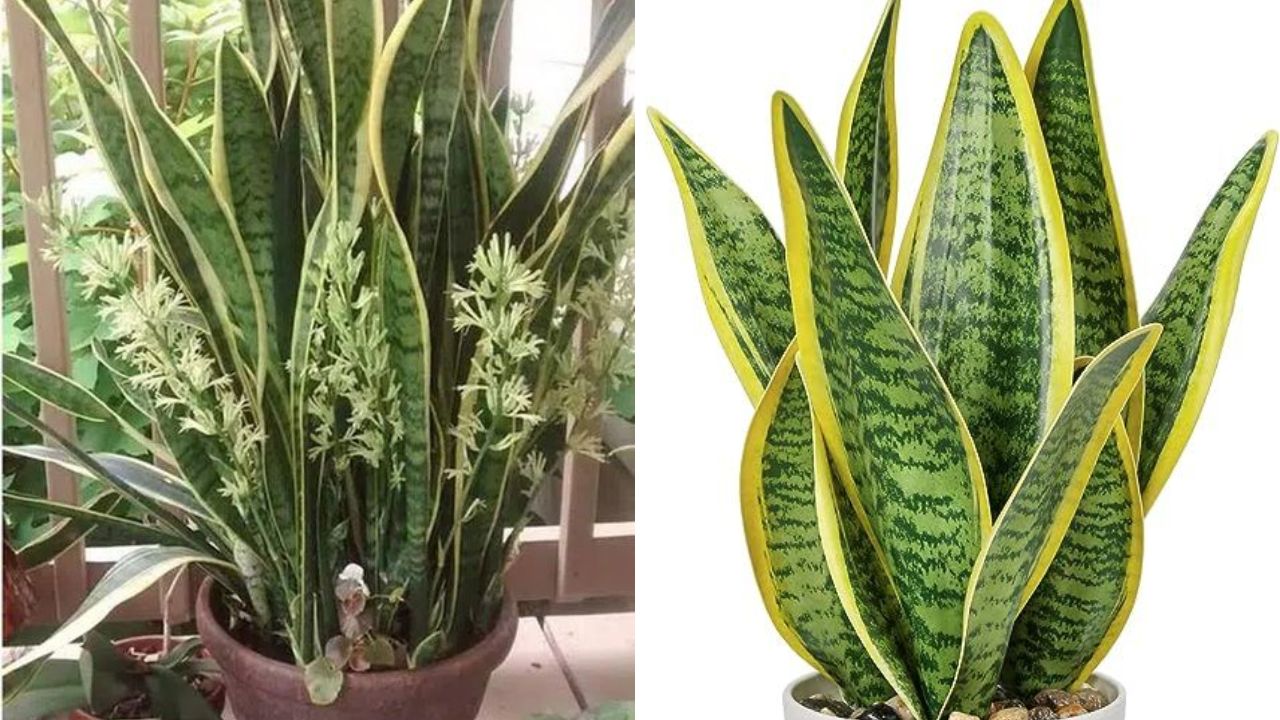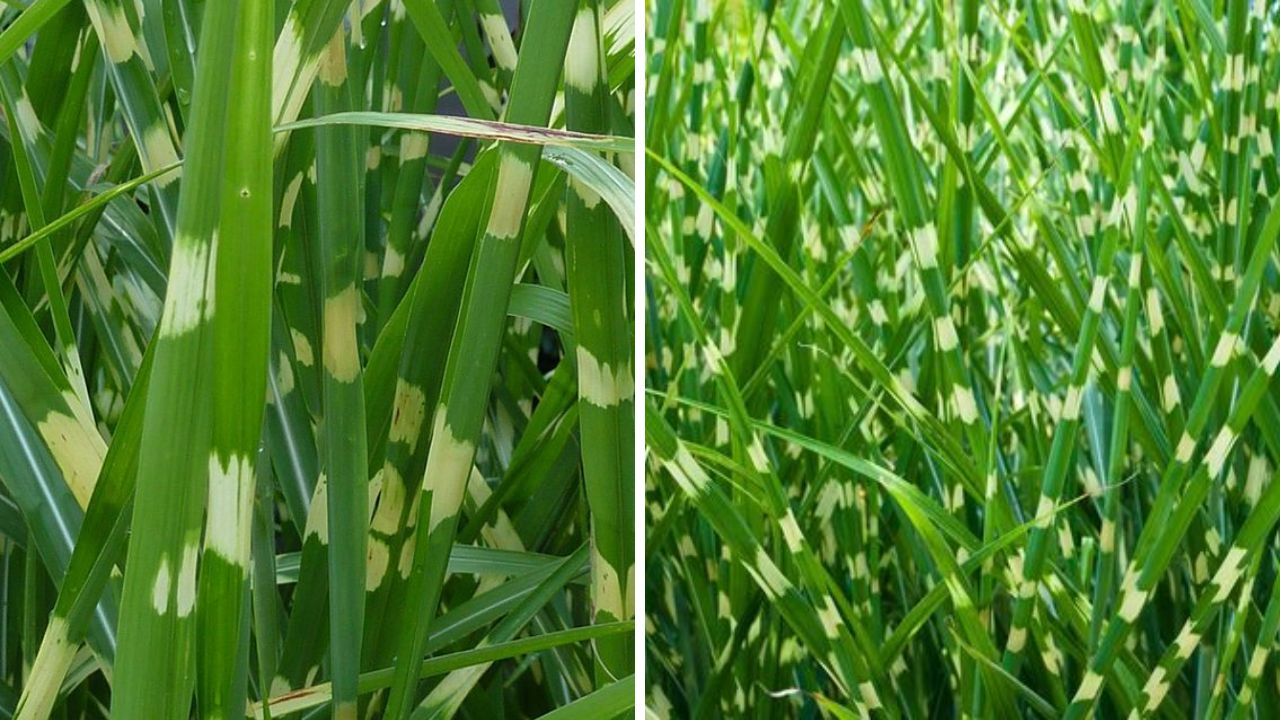With good cause, zebra grass (Miscanthus sinensis ‘Zebrinus’) is a favorite among ornamental grasses. It has an arching style and stands tall as a green sentinel in your landscape throughout the summer. After that, it produces tiny white blossoms and seed head plumes that provide visual appeal throughout the late summer months. Beautiful variegated leaves with creamy golden stripes that cross the typically green grass blades horizontally are another feature of zebra grass. The leaves start to turn more and more golden in the early fall. The tint of the leaves turns more toward beige by late fall.
Zebra grass is a real grass because it is a member of the Poaceae family. Greek words mischos (meaning “stalk”) and anthos (meaning “flower”) are the sources of its botanical name. Sinensis denotes a Chinese origin for the plant. ‘Zebrinus’, the cultivar name, refers to the stripes on the leaves of the plant, which resemble the stripes of a zebra.
Zebra grass can be planted in the spring or the fall and grows at a moderate to quick pace. To give the grass enough time to grow in its first season, spring planting is advised in areas with early or harsh winters. Zebra grass is one of several alien plants that can become an invasive species in your area due to its underground rhizomes.
Table of Contents
ToggleZebra Grass Overview

| Common Name | Zebra grass, maiden grass, Chinese silvergrass |
| Botanical Name | Miscanthus sinensis ‘Zebrinus‘ |
| Family | Poaceae |
| Plant Type | Ornamental grass |
| Mature Size | 7 ft. tall, 3-5 ft. wide |
| Sun Exposure | Full |
| Soil Type | Chalk, clay, loam, sand |
| Soil pH | Neutral |
| Bloom Time | Late summer |
| Flower Color | Silvery white |
| Hardiness Zones | 5-9 (USDA) |
| Native Area | Japan |
Zebra Grass Care

Because Miscanthus sinensis ‘Zebrinus’ can tolerate a wide range of soil conditions, it’s a fantastic choice for low-maintenance landscaping. This is a big ornamental grass that may grow up to 7 feet tall (measured from the top of the plume; the foliage will grow to be around 5 feet tall) and 3 to 5 feet wide when fully grown. Plant them 3 to 4 feet apart because it fills in areas fast and can spread easily through rhizomes. Zebra plants are very low maintenance because they are resistant to most pests and diseases, drought, and require very little water.
Light Requirements
Give your plants full sun for best development. The plant’s leaf blades may get floppy if it receives excessive shadow, but you may help keep them erect by giving them a stake or even a tomato cage.
Soil and Potting

Roughly neutral soil pH is preferred for zebra grass. Moist soils, or even muddy riparian edges, are ideal for this grass’s growth.
Watering
A mature specimen of zebra grass may withstand droughts and serve as an ornamental grass, but young plants require constant irrigation to establish themselves.
Temperature and Environment
The majority of warm-season ornamental grasses like soil temperatures between 70 and 90 degrees Fahrenheit, and sometimes even a bit higher. Give this plant a western exposure in a protected spot or one where the cold does not pocket in the cooler climates.
Fertilization
Apply compost or high-quality organic plant food as a spring fertilizer.
Types of Chinese Silvergrass
Zebra grass is simply one of the several varieties of Chinese silvergrass. Among the variations are:
Micanthus sinensis ‘Gracillimus’: Grows that grow to a height of five to six feet, with purple flower plumes in the summer that turn silver in the fall.
Micanthus sinensis ‘Flamingo’: reaches a height of 5 to 6 feet and has rose-pink flower plumes in the summer that turn silvery white in the winter.
Micanthus sinensis ‘Strictus’: This decorative grass, often called porcupine grass, is 6 to 8 feet tall and has variegated foliage with plumes that have a pinkish tint.
Micanthus sinensis ‘Silberfeder’: boasts variegated foliage, pinkish-silver plumes that emerge in late summer and turn white in the cooler months, and grows up to eight feet tall.
Pruning
Instead of trimming the stalks throughout the winter, some gardeners choose to leave them in place. Since these plants are useful for winter settings, pruning in this instance can wait until late winter or early spring. In addition to serving as mulch, the dead stalks shield the root system from the bitter cold of winter.
If you would rather cut the stalks off early, leave about 5 or 6 inches sticking up. In late winter or early spring, snip off the remaining 5 or 6 inches. In any case, the clump won’t look its finest in early spring when it first begins to put forth new growth, and the overall effect will be even less inspirational if you let the green shoots emerge from that 5 or 6 inches of stubble. Shearing the stalks all the way down to the ground in late winter or early spring is a much easier method.
Propagating Zebra Grass
You can divide the plant every few years in the spring, either before or soon after the grass blooms, or you can divide the grass clumps after the plant emerges from dormancy. Remember that trimming zebra grass is preferable than propagation. How to do it is as follows:
- Using a sharp spade, pick a healthy plant and remove it.
- To see the roots, turn the plant on its side.
- To get rid of the dirt, rinse the tangled mass of roots with water. This makes it possible for you to see any unhealthy or damaged roots.
- Using the sharp tip of the shovel, cut through the plant to split it in half or even thirds, depending on the size of the cluster.
- Utilizing gardening shears, trim any unhealthy roots.
- Replant the portions of ornamental grass as desired, giving them water as needed.
Potting and Repotting Zebra Grass
Growing zebra grass in a container may create a lovely visual display for any patio. Because it is housed in a pot, it will require a little extra watering and should be fertilized in the spring. Apply potting soil to a large container with drainage holes, plant it, and then water it. Just be aware that it will need to be divided since it will fill the container in less than a season.
Landscaping Uses for Zebra Grass
Zebra grass can be planted in the middle of shorter plants to create a focal point. It features enough boldness to be used as a specimen plant. Alternatively, plant it in hedges to take use of its screening properties. Because of the fine texture of its blades, it can be used to contrast with coarser plants. One or more bunches of zebra grass up against a wall or fence will look great in a rustic garden.
Zebra grass looks its best in late summer and early fall, therefore some gardeners choose to create a display area with the most visual interest possible during that time of year by pairing it with companion plants that likewise look their best from August through October. Examples of companion plants include:
- Chrysanthemum flowers
- Hardy hibiscus
- New England aster
You don’t have to worry about deer pests getting into your decorative grass because zebra grass is resistant to eating by them.
Overwintering
When early spring arrives, let your ornamental grass’s brownish-colored shoots remain before trimming them off. The stalks shield the root ball from the cold in addition to offering a little show in the garden.
Common Diseases
Like most ornamental grasses, zebra grass requires full sun and sufficient air circulation to help prevent fungal diseases like powdery mildew and leaf blight. It is possible to prevent fungal illnesses with appropriate care and upkeep. Zebra grass is hence a well-liked landscaping plant for any flower bed.
Also Read: Eastern Prickly Pear Cactus Complete Guide To Grow And Care





